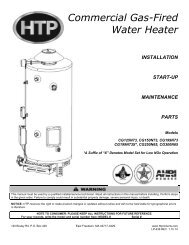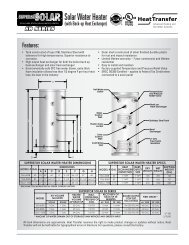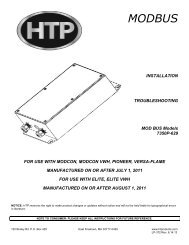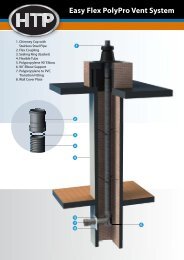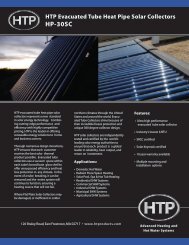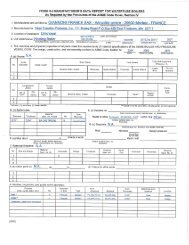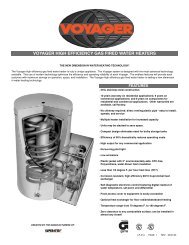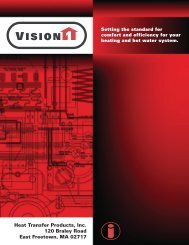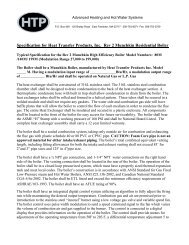MC Series Gas-Fired Circulating Heater - Heat Transfer Products, Inc
MC Series Gas-Fired Circulating Heater - Heat Transfer Products, Inc
MC Series Gas-Fired Circulating Heater - Heat Transfer Products, Inc
Create successful ePaper yourself
Turn your PDF publications into a flip-book with our unique Google optimized e-Paper software.
17<br />
C. SEPARATE LOW WATER CUTOFF<br />
A low water cutoff may be required by state and local codes, or by some insurance companies. A low water cutoff is also required if the<br />
heater is installed above the piping level. Check code requirements before installing the heater.<br />
If required:<br />
Use an electrode probe type low water cutoff designed for hydronic installations.<br />
Install in a tee on the supply piping above the heater.<br />
Follow low water cutoff manufacturer’s instructions.<br />
D. BACKFLOW PREVENTER<br />
Use a backflow preventer specifically designed for hydronic heater installations. This valve should be installed on the cold water fill<br />
supply line per local codes. (See piping details at the end of this section.)<br />
All piping methods shown in this manual use primary/secondary connection to the heater loop. This is to avoid the possibility of noise or<br />
actuator problems in zone valves because of the high-head heater circulator. For other piping methods, consult your local HTP<br />
representative or refer to separate piping details in this manual.<br />
E. SYSTEM WATER PIPING METHODS<br />
EXPANSION TANK AND MAKE-UP WATER<br />
1. Ensure expansion tank size will handle heater and system water volume and temperature. Allow 3 gallons for the heater and its<br />
piping.<br />
Expansion tanks must be sized according to total system volume. This includes all length of pipe, all fixtures, appliances, etc. Failure to<br />
properly size system expansion could result in wasted time, money, and possible property damage, personal injury, or death.<br />
Undersized expansion tanks cause system water to be lost from relief valve and make-up water to be added through fill valve. Eventual<br />
failure can result due to excessive make-up water addition. SUCH FAILURE IS NOT COVERED BY WARRANTY.<br />
2. Expansion tank must be located as shown in Piping diagrams, or following recognized design methods. See tank manufacturer’s<br />
instructions for details.<br />
3. Connect the expansion tank to the air separator only if the separator is on the suction side of the circulator. Always install the system<br />
fill connection at the same point as the expansion tank connection to the system.<br />
4. Most chilled water systems are piped using a closed type expansion tank.<br />
DO NOT install automatic air vents on closed-type expansion tank systems. Air must remain in the system and return to the tank to<br />
provide its air cushion. An automatic air vent would cause air to leave the system, resulting in water-logging the expansion tank.<br />
DIAPHRAGM (OR BLADDER) EXPANSION TANK<br />
Always install an automatic air vent on top of the air separator to remove residual air from the system.<br />
F. CIRCULATORS<br />
DO NOT use the heater circulator in any location other than the ones shown in this manual. The heater circulator is selected to ensure<br />
adequate flow through the heater. Failure to do so could result in unreliable performance and nuisance shutdowns from insufficient flow.<br />
LP-171 Rev. 10.2.13



